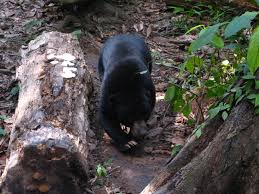With man-animal conflict on the rise in Kashmir, a first-of-its-kind scientific study has thrown light on the newer aspects of this conflict and the behaviour of the captured wild animals in the region.
 The research on captured Asiatic black bears at Dachigam by four wildlife scientists has revealed that wild animals venture out from the protected areas to human-dominated landscape during early springs and late autumn months in search of food as these areas have availability of high quality food than their natural habitats, which is forest and protected areas.
The research on captured Asiatic black bears at Dachigam by four wildlife scientists has revealed that wild animals venture out from the protected areas to human-dominated landscape during early springs and late autumn months in search of food as these areas have availability of high quality food than their natural habitats, which is forest and protected areas.
The study has also noted that captured animals who were translocated to Dachigam National Park for rehabilitation returned to the captured sites “possibly due to homing instincts or habituation,” highlighting a disturbing trend as far as management and mitigation of the man-animal conflict situation is concerned.
The return of such bears to their capture sites can be attributed to retain sharp memory and the habituation to the high quality human food in crops and orchards, the research has suggested, adding that the studies conducted on the Asiatic black bear in similar complex topography in Japan and Taiwan with agricultural lands and developed areas immediately adjacent to the bear habitats also report exploitation of human food sources by bears.
With Dachigam landscape being “well recognised as one of the highest density” bear populations in India, the scientific study on the black bear was undertaken in the background of increasing incidences of bear-human interactions and resultant retaliatory killings by locals, which have become a serious threat to the survival of black bears in the Dachigam landscape.
As per the latest figures by the government, man-animal conflict in J&K claimed 14 human lives, whereas 211 persons were injured in attack by wild animals during 2014-15, with majority of these attacks taking place in the Kashmir region.
The research study, published in an internationally reputed scientific journal ‘PLOS’ this week, may prove helpful for the wildlife authorities in J&K to manage the rising man-animal conflicts cases, particularly in the Kashmir valley, as it notes that translocation of “captured or conflict animals” is not enough to mitigate the human-animal conflicts.
The study revealed that “food resource availability plays a significant role in retaining bears inside Dachigam National Park as bears translocated during summer, when surplus food resources are available, remained in Dachigam National Park while bears translocated in food-stress period (spring and late autumn) returned to their capture sites.
“The Spatio-temporal mapping of bear food resources in Dachigam Landscape will be useful for identifying potential areas where conflict bears can be released and aversive conditioning in quarantine area may enhance the translocation success,” said Dr Mukesh Thakur, lead author of the research study. He is currently working as an associate professor in Amity University, Noida. The other three scientists who contributed to this research include Lalit Kumar Sharma, Samina Amin Charoo and Sambandam Sathyakumar.




